The British occupying forces originally used normal unoverprinted British stamps, but in 1942 overprinted them “M.E.F.” (Middle East Forces). An earlier proposal had been to overprint them “M.E.L.F.” (Middle East Land Forces). These were first released in north east Africa in Eritrea (March 1942) and in Italian Somaliland (13 April 1942); then in 1943 they were also released on the African Mediterranean in Cyrenaica and Tripolitania (now both in Libya), and eventually in the Greek Dodecanese Islands in 1945. A truly enormous geographical spread.
The MEF stamps were gradually replaced by overprinted issues for individual areas – see under East Africa Forces (1943), Eritrea (1948), Somalia (1948), Tripolitania (1948) – except for the Dodecanese Islands which continued to use MEF stamps until the end of the occupation in 1947, and Cyrenaica which had a new design inscribed with the territory name in 1950. As implied by the overprint the stamps were intended for use by military personnel rather than primarily as a public service.
There are four different settings of the overprint from 3 different issues. Not all of the settings were used in all of the areas of use.
1st issue: local overprint, 14mm x just under 3½ mm, oblong stops (Eritrea, Somalia)
2nd issue: local overprint, 13½mm x just over 3mm (Eritrea)
– (a) overprint with square stops
– (b) overprint with round stops
3rd issue: Harrison overprint, 13½mm, oblong stops (Eritrea, Cyrenaica, Tripolitania, Dodecanese Is)
Only the 5d presents a real problem with identification, between the rare 13½mm local overprint and the common 13½mm Harrison overprint, though the dark colours of the 2½d and 3d can sometimes make it difficult to distinguish the local overprint types against their dark background. Enlarged details of the four 5d overprints are shown, as an aid to identification, in the following table:
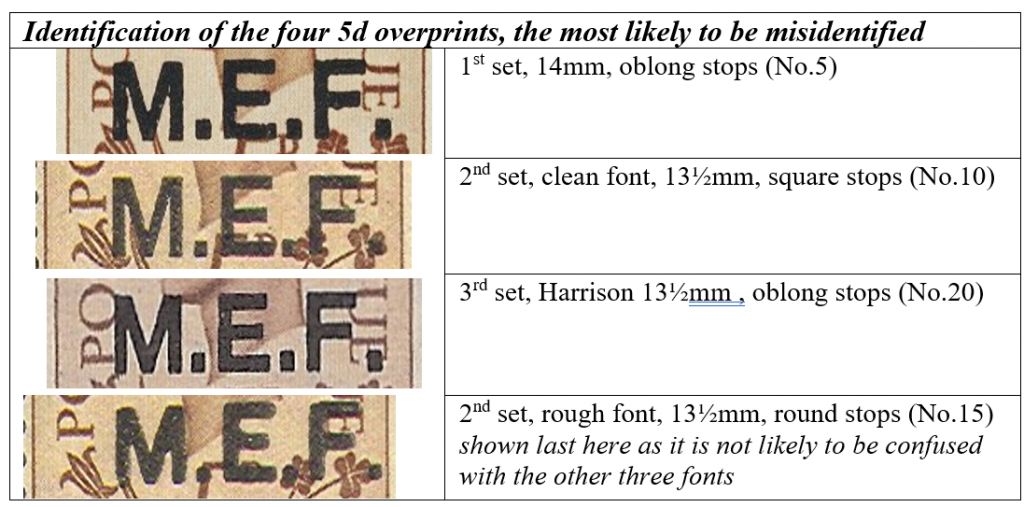
In the 13½mm overprint the lines of overprint are either in clean letters or in rough letters. It is not simply a matter of individual stamps or alternate rows: the clean overprint is in rows 2, 3 and 7 of each 6*10 pane, with the rough overprint on the other rows.
Numerous broken letters and full-stops are covered in the GBOS Study Papers.
There has been some mystery surrounding the first issues, though more recent research has clarified the position greatly. It is known that Harrisons overprinted the 1943 (pale colours + 5d) set, but it is not known for sure who printed the 1942 sets (dark colours + 5d), which appear to have been overprinted locally on British stamps already in the stores. The commonest “dark colours” set, with a nice clean 14mm overprint (used in Eritrea and Somalia), is now thought to have been overprinted by the Army Printing Services in Cairo and not (as previously thought) by Harrisons; the other “dark colours” set (used only in Eritrea), with a mixture of a nice clean 13½mm overprint alternating with a very rough font, is now commonly listed as being prepared by “an unidentified printer in the MEF area”. Alternative printers proposed for the latter include McCorquodales and a Greek printer in Cairo by the name of Murafatli. One report has the issue being printed in the back of an Army lorry near Nairobi. It is a matter of some note that a stamp issue prepared officially by the somewhat bureaucratic British army, and in use for nine months, should have no records of its place of printing.
The listings below follow the order of most British stamp catalogues. In the absence of more detailed information the same issue date has been indicated for the locally overprinted stamps, though this is probably not the case.

Selling price at the post office for the first issue
The stamps were not surcharged with a new face value, but Firebrace reports that in Eritrea and Somalia they were sold at 9c, 17c, 21c, 25c and 42c in East African cents and shillings, as used by the occupying East African Forces and for the stamps overprinted “E.A.F.”. According to an announcement in the “Eritrean Daily News” of 22 February 1942 (reproduced in The Overprinter 1980/1) “East African Currency and Lira coin will be accepted in payment of postal charges” for MEF stamps sold in Eritrea. The Overprinter 1980/2 reports that as these sale prices, calculated with reference to the strict exchange rate, did not correspond to the actual postage rates they were amended in 1944 in Somaliland for the EAF stamps (qv), and in Eritrea for the MEF stamps in 1946. Cyrenaica used the Egyptian Pound which was worth fractionally more than £1/0/6d sterling (see The Overprinter 1978/4 p.19).
First issue, 14mm overprint with oblong stops, Army Printing Services Cairo

| (SG №) | denomination | colour | date of issue | number issued |
| M1 | 1d | red | 2 February 1942 | not recorded |
| M2 | 2d | orange | 2 February 1942 | not recorded |
| M3 | 2½d | blue | 2 February 1942 | not recorded |
| M4 | 3d | violet | 2 February 1942 | not recorded |
| M5 | 5d | brown | 2 February 1942 | not recorded |

The “sliced M” occurs on all values on stamp R6/10 (The Overprinter 2008/2). For some years it was believed that it could not be found on the 3d, but that is now confirmed as existing. It is easier to see on the 1d, 2d and 5d because of the contrast with the background.
| Varieties | ||
| M1.v1 | 1d | sliced “M” |
| M2.v1 | 2d | sliced “M” |
| M3.v1 | 2½d | sliced “M” |
| M4.v1 | 3d | sliced “M” |
| M5.v1 | 5d | sliced “M” |
Minor misplacement of the overprint is not scarce; the 3d is known misplaced to the left so far that the “M” falls partly on the vertical perforations.
Second issue, type (a) 13½mm overprint, clean font with square stops unknown printer
The “number issued” is calculated from the known total issue for both versions of the overprint in this set (square and round stops), splitting it proportionately to the number of rows in each sheet with each setting, ie 30% square stops, 70% round stops.

| (SG №) | denomination | colour | date of issue | number issued |
| M6 | 1d | red | 2 February 1942 | 10,800 |
| M7 | 2d | orange | 2 February 1942 | 3,600 |
| M8 | 2½d | blue | 2 February 1942 | 10,800 |
| M9 | 3d | violet | 2 February 1942 | 3,600 |
| M10 | 5d | brown | 2 February 1942 | 1,584 |
The rare 5d No. 10 often misidentified for the common No.20 (see table at the start of section 11.2).
For controls and cylinders see the note in the next table, as the 3 rows in a normal control/cylinder corner block all had round stops.
Second issue, type (b) 13½mm overprint, rough font with round stops, unknown printer

| (SG №) | denomination | colour | date of issue | number issued |
| M6a | 1d | red | 2 February 1942 | 25,200 |
| M7a | 2d | orange | 2 February 1942 | 8,400 |
| M8a | 2½d | blue | 2 February 1942 | 25,200 |
| M9a | 3d | violet | 2 February 1942 | 8,400 |
| M10a | 5d | brown | 2 February 1942 | 3,690 |
The sheets normally had the margins removed in order to fit into the temporary overprinting press, so no control/cylinder information is known.

| Varieties | ||
| M9a.v1 | 3d | overprint double. In some older catalogues this was listed under the 1st set (No.4 above). In this variety the two overprints are virtually together, but show the typical blurring of a double overprint rather than a typical “kiss print”. |
| M9a note | 3d | the additional overprint shown above is probably a “kiss-print”, and as such would not be classified as a true double overprint. Less prominent examples on all values are not scarce. |
Pairs
Because of the alternation of rows with the two fonts vertical se-tenant pairs can be found. This leads to the ironic situation that se-tenant pairs of the two overprints are keenly sought after (and highly priced) but are actually slightly commoner than vertical pairs with the same overprint on each: if you remove the 3 se-tenant pairs from a column (1+2,3+4,7+8) you are left with two pairs of rough overprints (5+6,9+10), and there is only one way of making a pair of smooth overprints (destroying two adjacent se-tenant pairs).

Set 3, 1943 Harrison set, paler colours and new higher values
Only the 5d value presents problems in distinguishing it from the earlier sets, since the other values 1d-3d are on the paler colours issue, and the values of 6d and above were not included in the earlier issues.
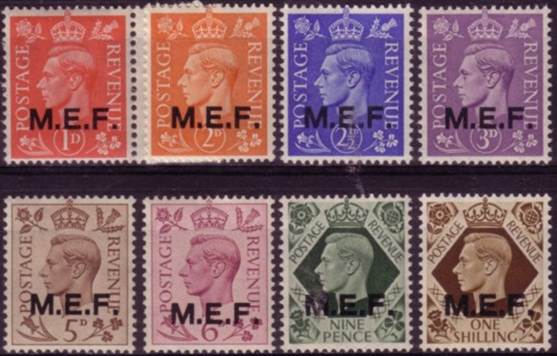
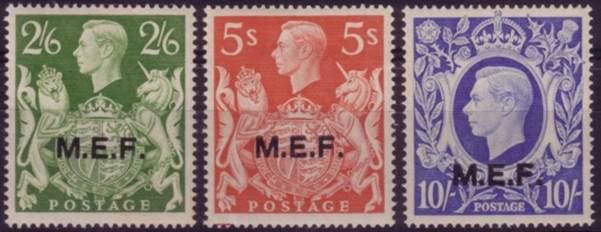
| (SG №) | denomination | colour | date of issue | number issued |
| M11 | 1d | pale red | 1 January 1943 | 2,338,263 |
| M12 | 2d | pale orange | 1 January 1943 | 2,387,731 |
| M13 | 2½d | pale blue | 1 January 1943 | 3,006,679 |
| M14 | 3d | pale violet | 1 January 1943 | 1,929,050 |
| M15 | 5d | brown | 1 January 1943 | 2,240,604 |
| M16 | 6d | purple | 1 January 1943 | 1,318,924 |
| M17 | 9d | green | 1 January 1943 | 1,030,036 |
| M18 | 1s | brown | 1 January 1943 | 2,060,434 |
| M19 | 2/6d | green | 1 January 1943 | 271,850 |
| M20 | 5s | red | 15 March 1947 | 101,830 |
| M21 | 10s | blue | 15 March 1947 | 130,986 |
The ½d pale green and 1½d pale brown exist with this overprint but only as proofs; they were never issued.
The 5d, No.20, is easily confused with the much rarer 5d No.10 (see table at the start of section 11.2).
Some of the “no dot” cylinders may be a case of the dot being removed by the perforation (see Appendix 1).
Controls Q45 and R45 could only have been used in the Dodecanese Islands, as the rest of the MEF territories as they had ceased to use them by the year shown in the control.
6d with control cylinder 25 is known with a missing jubilee line under stamp 20/10 (illustrated in The Overprinter 1989/2 p.127); according to the Gibbons GB Specialised Catalogue this happens on cylinder 37, but it is known on other cylinders such as this one and others noted in the lists for the MEF 9d, Eritrea, Somalia and Tangier, which have no cylinder in common, demonstrating that the variety occurs on more than one cylinder, and should not be used to infer the existence of a particular cylinder.
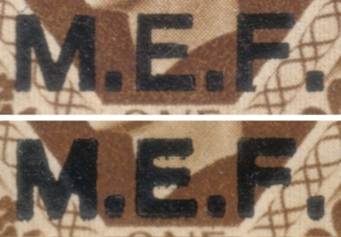
| Varieties | ||
| M18 note | 1s | this apparent doubling on the 1s stamp is probably caused by overinking and is not a true double overprint; kiss-prints are also known on some values |
Postage dues

| (SG №) | denomination | colour | date of issue | number issued |
| MD1 | ½d | green | 2 March 1942 | 336,613 |
| MD2 | 1d | red | 2 March 1942 | 243,941 |
| MD3 | 2d | black | 2 March 1942 | 242,887 |
| MD4 | 3d | violet | 2 March 1942 | 294,394 |
| MD5 | 1s | blue | 2 March 1942 | 260,344 |
For the postage due stamps, the left margin for those with imperforated bottom margin differ for some printings. Eg 3d and 1s control K42 have 7 pin holes in the left margin, compared to other controls being perforated right through the left margin:
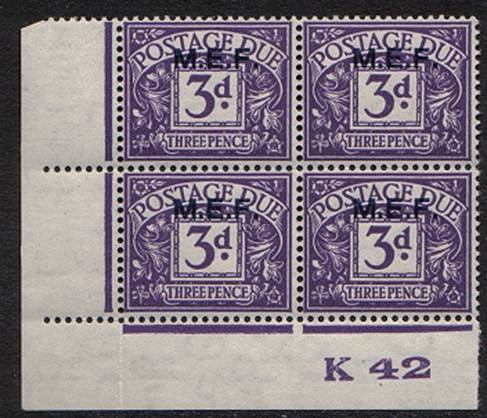
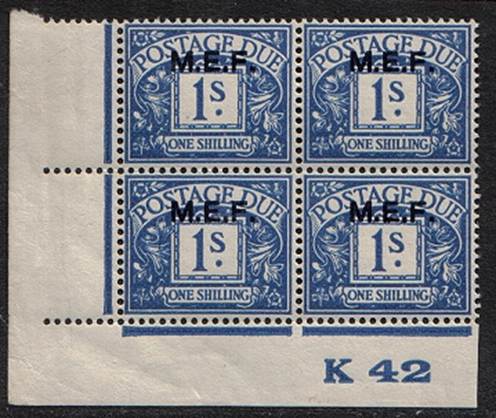
compare:

| Varieties | ||
| MD2.v1 | 1d | Control O44 with partial double perforations caused by large encroachment of marginal perforation |
| MD3.v1 | 2d | watermark sideways inverted |
References specific to this and related chapters
GBOS GB Overprints Compendium edition 8, Dr John Gledhill (12/4/2020)
Particular thanks go to Stanley Gibbons Ltd, for permission to quote their catalogue numbers and numerous other contributors who are mentioned in the Appendix section.
All content is copyright, Dr John Gledhill and the GB Overprints Society, May 2025.
